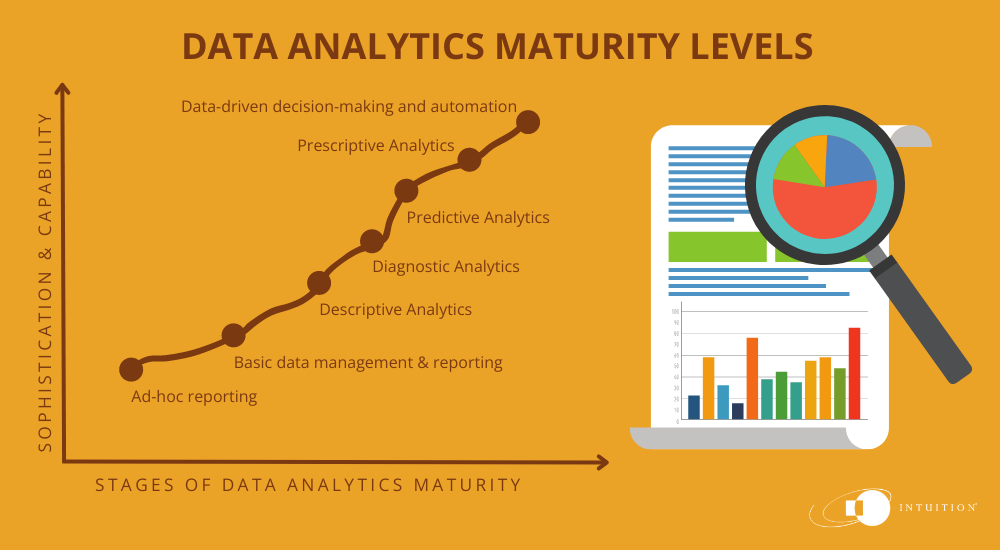Data analytics: Spurring growth from initial reporting to automation
In the age of information, data analytics has emerged as a powerful tool for businesses and organizations worldwide. It involves the systematic computational analysis of data or statistics and provides insights into trends, metrics, and patterns that can help inform decision-making processes. By leveraging data analytics, companies can optimize their operations, enhance their marketing strategies, and ultimately drive business growth.
The field of data analytics encompasses several types, including descriptive, diagnostic, predictive, and prescriptive analytics. Each type serves a unique purpose and offers different insights. For instance, descriptive analytics focuses on understanding past events; predictive analytics uses historical data to predict future outcomes.
However, the power of data analytics extends beyond just understanding past trends and predicting future outcomes. It is also concerned with using this information to automate processes, enhance efficiency, and drive growth in a variety of fields, including learning analytics.
Understanding data analytics maturity levels
The journey to harnessing the power of data analytics is a gradual process, often represented by data analytics maturity levels. These levels provide a roadmap for organizations looking to enhance their use of data analytics. They typically start from ad-hoc reporting, where an organization is just beginning to collect and analyze data, and progress through to data-driven decision-making and automation.
At the lower maturity levels, organizations may be grappling with basic data management and reporting. However, as they ascend the maturity ladder, they begin to adopt more complex data analytics strategies, including predictive analytics, data visualization, and automation. Each level brings with it increased sophistication and capability in data analysis, resulting in an organization that is not just data-driven but also capable of leveraging that data for automation.

The importance of data reporting in learning analytics
Data reporting forms the foundation of data analytics, especially in the field of learning analytics. It involves the collection and presentation of data in a way that is easily understandable and actionable. An example might be the presentation of student performance metrics, course completion rates, or learning outcomes.
In learning analytics, data reporting plays a pivotal role in informing instructional design, shaping learning interventions, and enhancing student engagement. By understanding the data, educators can identify patterns and trends in student behavior and performance, which can in turn help inform teaching strategies and enhance learning outcomes.
However, data reporting is just the first step in the data analytics journey. The true power of data analytics lies not just in understanding what the data says, but also in using these insights to visualize trends, predict future outcomes, and drive automation.
The role of data visualization in effective data analytics
Data visualization is a critical component of effective data analytics. It involves the presentation of data in a pictorial or graphical format, making complex data more understandable, accessible, and usable for a wider range of end users. Data visualization can help to highlight trends, patterns, and outliers in the data, making it easier for decision-makers to draw insights and make informed decisions.
In the context of learning analytics, data visualization can provide educators with a clear and comprehensive view of student performance, engagement, and outcomes. By visualizing the data, educators can identify trends, pinpoint problem areas, and develop targeted interventions to enhance learning outcomes.
Moreover, data visualization also plays a key role in predictive analytics and data foresight. It allows organizations to understand past trends and anticipate future outcomes, enabling them to make proactive decisions and strategies.
How data insight drives growth in businesses
Data insight refers to the actionable information derived from data analysis. It goes beyond a mere understanding of what the data says and delves into why certain trends or patterns exist. By understanding this why, organizations can develop strategies and interventions that address the root cause of issues, rather than just treating the symptoms.
In the business world, data insight can drive growth in various ways. It can help businesses to understand their customers better, enabling them to tailor their products and services to meet customer needs. By leveraging data insight, businesses can optimize their operations, enhance their marketing strategies, and drive customer satisfaction.
Moreover, data insight also plays a crucial role in predictive analytics and data foresight. By understanding the factors that drive certain trends or patterns, businesses can anticipate future outcomes and make proactive decisions that drive growth and profitability.
The future of data analytics: Data foresight
Data foresight represents the future of data analytics. It involves using data to anticipate future trends and outcomes, enabling organizations to make proactive decisions and strategies. Data foresight combines elements of predictive analytics and prescriptive analytics, using historical data to anticipate future outcomes and recommending actions to achieve desired results.
In the context of learning analytics, data foresight can help educators anticipate student performance and outcomes, enabling them to develop targeted interventions that enhance learning outcomes. By leveraging data foresight, educators are able not only to respond to student needs, but also to anticipate them, leading to improved teaching strategies and better learning outcomes.
Moreover, data foresight also represents a crucial step toward data automation. By anticipating future outcomes, organizations can automate processes and decisions, leading to increased efficiency and productivity.
Transitioning to data automation
Data automation represents the pinnacle of data analytics maturity. It involves using data analytics to automate processes and decisions, leading to increased efficiency and productivity. Data automation can take various forms, from automated reporting and data visualization, to predictive analytics and decision automation.
In the field of learning analytics, data automation can help to automate various aspects of the learning process, from student assessment and feedback to personalized learning pathways. By leveraging data automation, educators can enhance efficiency, personalize learning, and improve learning outcomes.
However, transitioning to data automation is not a simple process. It requires a robust data infrastructure, advanced analytics capabilities, and a clear understanding of the processes to be automated. Moreover, it also requires a shift in mindset, from treating data as a tool for understanding to viewing it as a tool for action.

Benefits of data automation in learning analytics
Data automation brings numerous benefits to the field of learning analytics. Firstly, it can enhance efficiency by automating routine tasks such as data collection, analysis, and reporting. This frees up time for educators to focus on more value-added activities, such as developing teaching strategies and engaging proactively with students.
Secondly, data automation can help to personalize learning. By leveraging data analytics, educators can develop personalized learning pathways that cater to the unique needs and preferences of each student. This can lead to improved learning outcomes, as students are more likely to engage with material that is relevant and interesting to them.
Finally, data automation can also help to improve decision-making. By automating the analysis and interpretation of data, educators can make more informed decisions about teaching strategies, learning interventions, and resource allocation.
Conclusion: The journey from data reporting to automation in learning analytics
In conclusion, data analytics represents a powerful tool for driving growth in businesses and organizations. It involves a journey from basic data reporting to advanced data automation, with each step bringing increased sophistication and capability in data analysis.
In the field of learning analytics, this journey can lead to numerous benefits, from improved teaching strategies and learning outcomes to enhanced efficiency and personalized learning. However, this journey requires a robust data infrastructure, advanced analytics capabilities, and a clear understanding of the processes to be automated.
As we move into the future, data analytics will continue to evolve, with data foresight and automation representing the next frontier. By harnessing the power of data analytics, businesses and organizations can not just understand the world, but also shape it, paving the way for growth and success in the age of information.


